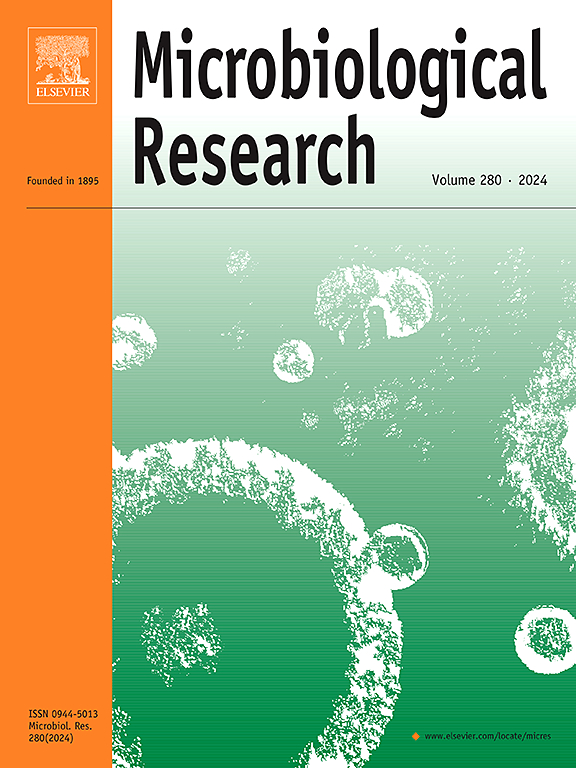Haem is involved in the NO-mediated regulation by Bradyrhizobium diazoefficiens NnrR transcription factor
IF 6.1
1区 生物学
Q1 MICROBIOLOGY
引用次数: 0
Abstract
Nitric oxide (NO) and the greenhouse gas (GHG) nitrous oxide (N2O) contribute significantly to climate change. In rhizobia, the denitrifying enzyme c-type nitric oxide reductase (cNor), encoded by norCBQD genes, is crucial for maintaining a delicate balance of NO and N2O levels. In the soybean endosymbiont Bradyrhizobium diazoefficiens, maximal expression of norCBQD genes in response to NO is controlled by NnrR, which belongs to a distinct clade of the CRP/FNR family of bacterial transcription factors. This protein participates in the FixLJ-FixK2-NnrR regulatory cascade that induces denitrification genes expression in response to oxygen limitation and nitrogen oxides. However, the molecular mechanism underpinning NO sensing by B. diazoefficiens NnrR has remained elusive. Here, we revealed that NnrR induces norCBQD gene expression in response to NO uncoupled from the superimposed FixK2 control. Moreover, NO-mediated induction by NnrR is dependent on haem, as the expression of a norC-lacZ fusion was impaired in a hemN2 mutant defective in haem biosynthesis. In vitro studies showed that NnrR bound haem with a 1:1 stoichiometry (monomer:haem), according to titration experiments of recombinant NnrR protein with hemin performed under anaerobic conditions. Furthermore, the full UV-Visible spectra of haem-reconstituted NnrR showed a peak at 411 nm (ferric form), and at 425 nm (ferrous derivative). This latter complex was able to bind NO under anaerobic conditions. Finally, we performed a functional mutagenesis of specific residues in NnrR predicted as putative ligands for haem binding. While H11 was important for norC expression and Nor activity, a H11A-H56A protein variant showed a reduced affinity for haem binding. Taken together, our results identify haem as the cofactor for NnrR-mediated NO sensing in B. diazoefficiens denitrification, with H11 as a key residue for NnrR function, providing the first insight into the mechanism of an NnrR-type protein. These findings advance our understanding of how bacterial systems orchestrate the denitrification process and respond to environmental cues such as NO.
血红素参与了缓生根瘤菌重氮效率NnrR转录因子介导的no调控
一氧化氮(NO)和温室气体(GHG)一氧化二氮(N2O)对气候变化有重要贡献。在根瘤菌中,由norCBQD基因编码的反硝化酶c型一氧化氮还原酶(cNor)对维持NO和N2O水平的微妙平衡至关重要。在大豆内共生菌重氮慢根瘤菌中,norCBQD基因对NO的最大表达受NnrR控制,NnrR属于细菌转录因子CRP/FNR家族的一个独特分支。该蛋白参与FixLJ-FixK2-NnrR调控级联,诱导反硝化基因表达以响应氧限制和氮氧化物。然而,B. diazoefficiens NnrR感知NO的分子机制尚不明确。在这里,我们发现NnrR诱导norCBQD基因表达,以响应NO从叠加的FixK2对照中解耦。此外,NnrR介导的no诱导依赖于血红素,因为在血红素生物合成缺陷的hemN2突变体中,norC-lacZ融合的表达受损。体外研究表明,重组NnrR蛋白与血红素结合的化学计量比例为1:1(单体:血红素),在厌氧条件下进行了重组NnrR蛋白与血红素的滴定实验。此外,血液重构的NnrR的全紫外可见光谱显示出411 nm(铁形式)和425 nm(铁衍生物)的峰值。后一种复合物能够在厌氧条件下结合NO。最后,我们对NnrR中被预测为血红素结合配体的特定残基进行了功能性诱变。虽然H11对norC表达和Nor活性很重要,但H11A-H56A蛋白变体对血红素结合的亲和力降低。综上所述,我们的研究结果确定血红素是B. diazoefficiens反硝化过程中NnrR介导的NO感知的辅助因子,而H11是NnrR功能的关键残基,首次揭示了NnrR型蛋白的机制。这些发现促进了我们对细菌系统如何协调反硝化过程和对环境线索(如NO)的反应的理解。
本文章由计算机程序翻译,如有差异,请以英文原文为准。
求助全文
约1分钟内获得全文
求助全文
来源期刊

Microbiological research
生物-微生物学
CiteScore
10.90
自引率
6.00%
发文量
249
审稿时长
29 days
期刊介绍:
Microbiological Research is devoted to publishing reports on prokaryotic and eukaryotic microorganisms such as yeasts, fungi, bacteria, archaea, and protozoa. Research on interactions between pathogenic microorganisms and their environment or hosts are also covered.
 求助内容:
求助内容: 应助结果提醒方式:
应助结果提醒方式:


